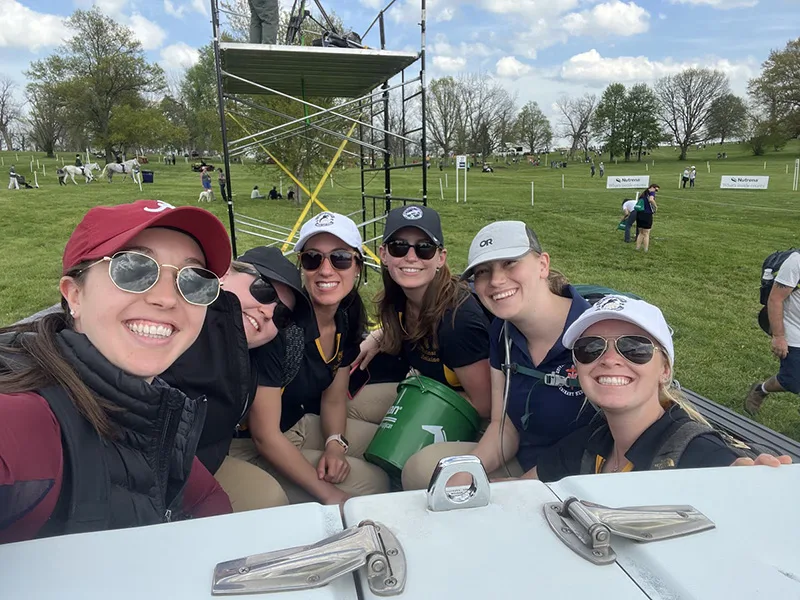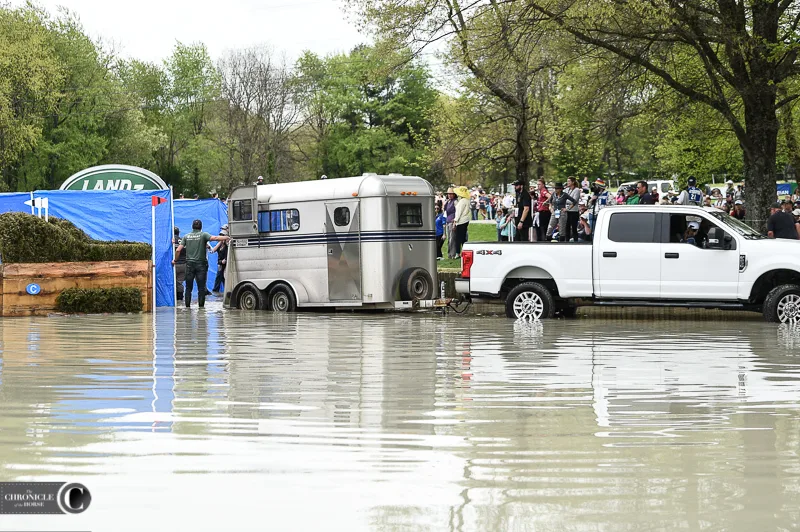Jackie Guezille is a second-year veterinary student at Tufts University Cummings School of Veterinary Medicine (Massachussetts) and amateur dressage rider who plans to become an equine sports medicine veterinarian. She was one of approximately 40 students from veterinary schools across the country who attended the Land Rover Kentucky Three-Day Event at the invitation of the American Association of Equine Practitioners (AAEP) to shadow and assist the veterinary team there. Here, she shares her experience viewing the country’s biggest event through the eyes of a vet.
I received an email two weeks prior to the start of the Land Rover Kentucky Three-Day Event telling me I was among a group of veterinary medicine students accepted to shadow veterinarians working one of the most prestigious equestrian championships in the United States. It became a mad dash to book flights, hotels and rental cars to make it to Lexington, Kentucky, from my home in North Grafton, Massachusetts, but I knew this was the opportunity of a lifetime.
Upon arriving on Friday afternoon, we veterinary students gathered inside the Zoetis tent at the Kentucky Horse Park to meet with the show veterinarians. The vets gave us the game plan on how Saturday’s cross-country phase would run, where vets would be stationed, and how the D box (the area where horses are inspected by veterinarians after finishing the course) would function. One of the veterinarians offered to take students in his truck, so I immediately introduced myself and snagged a spot working on the course for cross-country day.
On Saturday morning, we set up between our assigned fences, the first and last jumps on course, an hour before the four-star started. The vet I worked with, Dr. John Nenni of Hyde Park Veterinary Clinic in Cincinnati, Ohio, shared what he was looking for as the horses came down to the jumps.

Author Jackie Guezille, left, with fellow vet students, from left, Jamie Bassett (Tufts Cummings School of Veterinary Medicine), Sarah Brackett (University of Missouri College of Veterinary Medicine), Madeline Capodanno (University of Missouri College of Veterinary Medicine), Kira Conklin (University of Illinois) and Ali Sturtevant (University of Missouri College of Veterinary Medicine) get a lift out to the course on cross-country day at the Land Rover Kentucky Three-Day Event. Photo Courtesy Of Jackie Guezille
Every jump on course has a veterinarian watching it, with some veterinarians watching multiple jumps that can easily be viewed from one vantage point, noting whether the horse taps or hits the jump, if the horse looks tired, has any visible cuts or scrapes that need to be checked out in the D box, and whether the horse is breathing excessively hard as it gallops through the course. Each veterinarian has a radio to relay this information, so that the other veterinarians on course and the ground jury are aware of how each competitor is doing. If a horse raps several jumps in a row, the vets on course are alerted and watch to see if the horse stays sound, if it continues to hit jumps, or is having a tough time making it over jumps. The veterinarians watching the jumps cannot pull up a horse, but they can alert the ground jury if a horse appears unsound or is having difficulties on course.
ADVERTISEMENT
There was not a second during the hours of four- and five-star cross-country when the vets on course were not on high alert and in constant contact with each other. When two horses ran into issues that required assistance, the horse ambulance was quickly summoned, and screens were set up to give the horse and rider privacy as the vets worked on them. In situations like this, no further details are given on the radios besides which vets are needed where and if standing transportation or the horse ambulance is needed. This ensures that the status of the horse and rider are kept confidential until the rider and the veterinary delegate for the event make a statement about the incident.

The specially fitted horse ambulance responded to the Head of the Lake to transport a horse to Hagyard Equine Medical Institute. Lindsay Berreth Photo
We had several spectators ask about the status of certain horses, but the only thing the veterinarians on course are allowed to say is that the horse is being given veterinary attention. Luckily, the horse park is right across from Hagyard Equine Medical Institute, a premier veterinary hospital, so transportation was short for the horses that needed it.
Like the horse ambulance (which comes from the Massachusetts Society for the Prevention of Cruelty to Animals and is driven down all the way down to Kentucky to be available for the event), most vets bring their own vehicles and supplies.
The vet who allowed me to tag along—and ask him approximately a million questions about the event—had his vet box in the back of his truck, so it carried what he usually has on a day-to-day basis. Before the start of cross-country, he prepared a smaller bag with sedation, a few rolls of Vetrap, threaded a needle with suture material in case a catheter needed to be inserted so as not to waste precious time if the need arose, a tracheal tube for intubation, and a Kimzey splint. Kimzey splints align the pastern, coffin and navicular bones for stabilization and immediate pressure relief on an injured area, so the horse is standing on its tip toe but can walk, even in cases where a tendon or ligament is injured. The brace allows a horse to be walked onto a trailer and taken for further evaluation instead of being placed on a glider, which is more difficult to situate the horse on and requires the horse to be sedated.
Once the four-star and five-star riders had completed cross-country, the veterinarians and vet students converged on the D box at the end of the course for a debriefing session. Each vet went over how their respective jumps rode, what needed to be improved and what went well. For example, there was an issue with cell phone service at the Kentucky Horse Park due to the sheer number of people there so, ironically in this modern age, radios became the sole mean of communication for the vets and officials.
ADVERTISEMENT
Several of the veterinarians had worked the event for multiple years, and they all agreed that the frangible technology helped avoid injuries, particularly on Fence 6 of the four-star course, the Park Question coffin. It was great to see seasoned veterinarians agreeing that course safety is definitely improving and keeping horses and riders safe.
The jog the following morning confirmed that the vets had correctly tracked horses that had a difficult time on cross country. Those horses usually appeared a little stiff or off during the jog, and a few were held for re-inspection.

Veterinarians, right, confer with the ground jury Sunday morning before a horse is represented during the second jog of the Land Rover Kentucky Three-Day Event. Kimberly Loushin Photo
The veterinary delegate held another debriefing for the vet students after the jog to explain that they were looking for “competition sound,” which may differ from what we would expect to see from a fully rested horse that had not just run several thousand meters through hilly terrain and over massive jumps the previous day.
There was another discussion during that debriefing about what could be improved about the overall event, what went well, and questions answered by an FEI team veterinarian before the vet students broke for the day. Thereafter, the students became regular spectators for the show jumping portion, free to shop, watch, and soak in the rest of the weekend atmosphere.

Guezille (center) and fellow Tufts vet students Radhika Sharma (left) and Jamie Bassett (right), in the uniform khakis that let vets and vendors know they were vet students, got into the spirit of the weekend, posing in front of the Kentucky Horse Park’s iconic statue of Bruce Davidson Sr. Photo Courtesy Of Jackie Guezille














